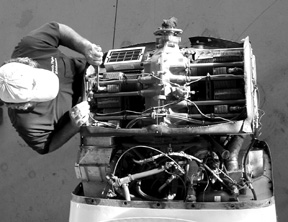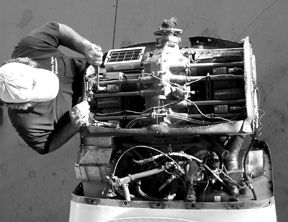
by Mike Busch
Nothing is more frustrating than dealing with mechanical problems while on the road. Its always uncomfortable when youre far away from your usual support system-your trusted mechanic, your hangar, your toolbox. To add insult to injury, mechanicals invariably seem occur at the most inconvenient possible time and place-like Sunday at Sheepdip County Airport when youve just gotta be back at work Monday morning. Itll be a miracle if you can find a local A&P at Sheepdip on a Sunday … and if you do, youll get the uneasy feeling that Bubba knows hes got you and your American Express card by the short ones.
Its natural to ask yourself whether its really necessary to fix the problem before further flight, or whether its okay to press on and get it resolved after you return home. Theres a strong temptation to defer the maintenance until a more convenient time, and often thats a perfectly reasonable thing to do. But sometimes it isnt-witness numerous NTSB accident reports in which the probable cause is pilots decision to operate the airplane with a known deficiency.
So, do you fix it now … or fix it later? Is fixing it now really necessary? Is fixing later really safe? It all depends.
Whats Wrong, Exactly?
When wrestling with these and other issues, your first question should be this: Do I know exactly whats wrong? Unless you are confident that you know the cause of a problem, you cant make an informed decision about how serious it is and whether or not its safe to fly with it.
Often the cause is obvious-flat tire, inoperative radio, burned-out landing light bulb, noisy attitude gyro-and your decision is often straightforward. Sometimes, however, the cause is not so obvious. Are you absolutely certain about where that fine oil mist on the windshield is coming from? What that slight fuel odor in the cockpit really means? Why the engine seems to be running rougher than usual? Does that dead #5 EGT indication signifies a non-firing cylinder or just a broken wire? In cases like these, you need to investigate further before making a go/no-go decisionExperience teaches us that even seemingly minor anomalies are worth investigating before flight. I recall one occasion when I noticed a little static in my comm radios that I never heard before. It was so subtle that Id have completely ignored it if I had been flying any other aircraft other than mine. But I knew my airplane well enough to know this wasnt normal, so I investigated further. After some experimentation, I discovered that the noise would disappear when I turned off the right magneto on the left engine.
I pulled the left engines cowling and discovered the nuts securing the ignition harness to the right magneto were loose and backing off the studs-one was completely gone and the other three were well on their way. Had I not followed up on the static in the radios, the harness could easily have fallen off the mag in a few more flight hours.
Another time, while flying home to California from Oregon, I spotted a tiny trickle of reddish liquid on the top of the left engine nacelle. Since the only red liquid I could think of was the red-dyed oil in the hub of my McCauley propellers, I decided to make a precautionary landing to investigate. It turned out that there was a major problem with the prop due to an assembly error when the props were overhauled three years earlier that could have resulted in loss of a blade in-flight … which quite often is a fatal scenario.
The moral: Dont fly with an anomalous symptom-even a seemingly innocuous one-unless and until youre satisfied you know exactly whats causing it.Once you know the cause, you can make an informed decision whether to fly now and fix later or vice-versa.
Safe To Fly?
Okay, you have a problem and youve determined its cause. Now, how do you decide whether or not its safe to fly home with the problem? Thats not an easy question to answer. Risk-assessment questions never are. Its a lot like asking if its safe to fly in this weather. There are a lot of variables to consider, and every pilots risk tolerance is different. Personally, Im reluctant to fly with any significant problem that affects the engine(s), propeller(s), landing gear or primary flight controls.
Some years ago, a Bonanza-owner friend discovered at runup that one of his two mags was misfiring badly. Instead of opting to fix it before further flight, he elected to fly home with the bad mag shut off; he made it, but I still think it was a dumb stunt. Ive known piston-twin pilots who tolerate a substandard mag check in one engine if the other engine is running fine, but Im definitely not one of them-an engine failure in a piston twin can sometimes be more dangerous than one in a single.
All but oddball or older piston twins have dual alternators and dual vacuum pumps. Many singles also have backup vacuum systems and some even have backup alternators. Is it okay to fly with a bad alternator or vacuum pump if youve got another one thats still working? For me, the answer is yes, but only if the flight is day VFR, and a resounding no at night or in IMC. Your mileage may vary, of course, but its wise to establish your own minimum equipment list (MEL) criteria for problems like this ahead of time, otherwise you may succumb to the siren song of get-home-it-is.
One of my personal MEL rules is that my autopilot is a no-go item if the flight is in IMC, at night, or if it exceeds one hour in duration. The only exception is if theres another rated pilot in the right seat. I confess that my own mileage has varied on this one over the years: I used to fly my Skylane solo in nasty weather and believed that real pilots dont need autopilots or dual vacuum pumps. I was young, stupid and invulnerable at the time. Nowadays, more old and less bold, I wont make anything but a quick sightseeing flight without dual vacuum pumps and George along. If that means fixing it on the road, thats what I do.
Will It Get Worse?
Any time you consider flying with a minor mechanical problem, you need to ask yourself if youre confident that your minor problem wont turn into a major problem before you make it home. Will that noisy attitude gyro keep gyroing for another five hours? Will that small fuel seep stay small, or will it turn into a dangerous leak? If you stop-drill that windshield crack, will it stop growing long enough to fly back to home base? Sometimes a quick-and-dirty temporary fix is adequate to get you home so you can put the aircraft in the shop and do a proper repair.
I once flew to Louisiana for an overnight stop en route to a speaking engagement in the Cayman Islands. The next morning, I was horrified to discover that the pilot-side window was cracked from the lower-front corner of the storm window opening to the edge of the frame. I didnt feel safe flying in that condition all the way to the Caymans and back to California, but replacing the window would require downing the airplane for several days and no-showing my engagement.
I wound up drilling two rows of 1/16-inch holes, one row on either side of the crack, and stitching the window back together with stainless steel safety wire. It was a truly ugly repair, but one that is FAA-approved in Advisory Circular AC43.13-1B and took less than 30 minutes to accomplish. It held together just fine until I got back home and installed a new window.
Another time, I discovered an electrothermal deicer coming loose from one of my propeller blades. I couldnt fly with it in that condition, but couldnt easily down the airplane for a few days to get it replaced. After my best efforts to re-glue it failed miserably, I finally wound up securing it temporarily with duct tape-a decidedly unapproved repair, but one that worked long enough to get me home where I could install a new deicer. I still shudder to think what would have happened if Id been ramp-checked with duct tape on my prop!
!@#$%^&* Intermittents!
Intermittent problems are always the worst to deal with, particularly away from home. Invariably, such problems never happen when youre trying to show them to the mechanic. Since a mechanic cannot properly troubleshoot a problem that he cannot reproduce, he has only two options: (1) confess to you he doesnt know whats wrong, or (2) make a guess on what might be wrong and replace one or more parts based on that guess. Mechanics hate to admit they dont know how to fix your problem, so more often than not they wind up guessing and hoping they get lucky. More often than not, such shotgunning winds up costing you time and money and doesnt cure the problem. That goes double when youre on the road.
If your intermittent problem is potentially life-threatening-for example, intermittent oil pressure fluctuations-then naturally you have little choice but to deal with it right away, even if that requires guesswork, downtime and expense. But most intermittents arent life-threatening, and for those the best approach is often to be patient and wait until the problem worsens to the point that it can be reproduced and troubleshot. For such problems, deferring it until you get home is often the wisest course of action.
Sometimes, of course, the problem wont wait until you get home, and will worsen to the point you need to deal with it. Some years ago, I flew from California to New England shortly after completing a heavy annual that involved replacing the turbochargers on both engines. The engines ran perfectly all the way to New Haven, Conn. Then, while climbing out from New Haven for Boston, the right engine stumbled-once-for about a second, then ran perfectly for the remainder of the 30-minute flight. After landing, I performed an extensive runup and everything seemed perfectly normal. Although I was concerned, I chose not to deal with it.
A few days later, the right engine started running rough-very rough-and this time the problem wasnt intermittent. Shoving the mixture to full rich smoothed out the engine considerably. An in-flight mag check seemed normal.By the time I landed, I knew I had a problem with the right engine, and knew that it was most likely fuel-related. That was enough to go on, and 30 minutes later found that the #4 fuel injector nozzle was partially clogged.
To make the right fix-or-defer decision, a pilot needs to know the airplane, properly diagnose the malfunction and consider the consequences of the problem, the weather and whether the proposed fix will actually resolve it. Sometimes, its not an easy decision, but with experience, you can learn to make the right one.
Also With This Article
“You Make The Call”
“What Should You Carry?”
“When To Say No”
Mike Busch, co-founder of our all-electronic sister publication, AVweb, is a 7000-hour CFII-ME and A&P who conducts the Savvy Aviator seminars (www.savvyaviator.com) for aircraft owners.-




